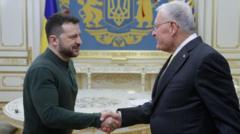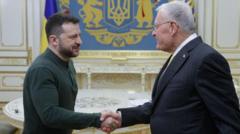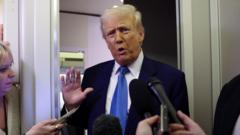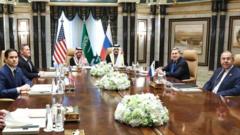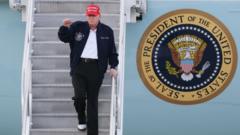In a surprising policy reversal, President Trump has expressed his intention to pursue a renewed nuclear agreement with Iran, despite earlier opposing the 2015 deal. This shift comes alongside a reactivation of his "maximum pressure" campaign to counter Iran's strategic moves.
Trump's Shift on Iran: From Withdrawal to Negotiation

Trump's Shift on Iran: From Withdrawal to Negotiation
President Trump plans to negotiate a new nuclear deal with Iran, a stark contrast to his previous stance that led to withdrawing from the 2015 agreement.
In a recent statement, President Trump signaled his intention to initiate negotiations for a "verified nuclear peace agreement" with Iran. This announcement marks a significant turnaround from his previous term when he strongly criticized the 2015 nuclear deal brokered by former President Barack Obama, which he described as a flawed accord.
Trump's latest proposal came via social media, where he mentioned the possibility of a celebration in the Middle East upon the completion of a new deal, emphasizing his desire for Iran to emerge as a successful country while possessing no nuclear weapons. This stance hints at an aspiration for diplomatic relations and peace in the region.
However, only hours before this diplomatic overture, Trump announced a renewed “maximum pressure” strategy directed at Iran, imposing stringent economic sanctions aimed to curb Tehran's nuclear ambitions, ballistic missile program, and support for terrorist organizations. This dual approach of offering negotiations while simultaneously ramping up pressure has drawn criticism and skepticism about his true intentions.
The Iranian government responded swiftly, reiterating its commitment to not pursuing nuclear weapons and rejecting the notion that U.S. sanctions were justified. This reaction highlights the complex dynamics at play as Trump shifts his strategy towards Iran, where diplomacy and military pressure coexist uneasily.
As these developments unfold, the international community watches closely to see whether this proposed engagement strategy will yield fruitful negotiations or escalate tensions further in the Middle East.
Trump's latest proposal came via social media, where he mentioned the possibility of a celebration in the Middle East upon the completion of a new deal, emphasizing his desire for Iran to emerge as a successful country while possessing no nuclear weapons. This stance hints at an aspiration for diplomatic relations and peace in the region.
However, only hours before this diplomatic overture, Trump announced a renewed “maximum pressure” strategy directed at Iran, imposing stringent economic sanctions aimed to curb Tehran's nuclear ambitions, ballistic missile program, and support for terrorist organizations. This dual approach of offering negotiations while simultaneously ramping up pressure has drawn criticism and skepticism about his true intentions.
The Iranian government responded swiftly, reiterating its commitment to not pursuing nuclear weapons and rejecting the notion that U.S. sanctions were justified. This reaction highlights the complex dynamics at play as Trump shifts his strategy towards Iran, where diplomacy and military pressure coexist uneasily.
As these developments unfold, the international community watches closely to see whether this proposed engagement strategy will yield fruitful negotiations or escalate tensions further in the Middle East.



